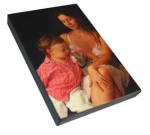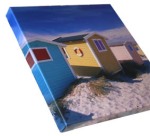How good does my photo have to be to create a personalised Photo on Canvas?
I get asked this question every day from customers wanting to know the answer. The answer is – there is no answer. There are so many variables involved with producing a canvas print and so many variables in the quality of photos taken – from the photographer through to the camera they use.
Unfortunately it is not as easy as saying – “just make sure you take your photo with a certain megapixel camera” – that would be too easy, and make my life much simpler. I often have people come into my canvas printing studio with bad photos taken from a really high megapixel camera and great photos taken from early digital cameras with low megapixels – more and more I am getting great results from mobile phone cameras as well. The answer is not just in the megapixel, a lot has to do with the way the camera was made and the quality of the processor and lens – not something that the manufacturers use as a selling feature. The better the processor in your camera the better the canvas print.
My advice is – if you are not sure, ask ROC Canvas Prints. We can take a quick look at your image and let you know if it is suitable. More often than not it is not a case of if it is suitable, but how big it will go before looking too grainy.
Something to also take into account is the textured surface of the canvas. Printing on canvas can be very forgiving to an image, what might look terrible on paper can look stunning on canvas.
Photography Tips
To ensure your photos are the best they can be with the camera you own, I have included some basic photography tips you can follow. I include new tip every month in the monthly newsletter I send out every month. If you would like you can register to receive my monthly canvas printing newsletter.
1. Making the most of your light:
The most important aspect of your photograph, outside of the person or content you are photographing, is light. You can alter your photographs dramatically just by changing the way the light falls across your subject. For example: bright sunlight can enhance an older person’s wrinkles, but a softer light on an overcast day can subdue those same wrinkles.
2. Off centre your subject:
Bring your pictures to life by placing your subject off centre. Moving your target away from the middle of your image, not only from side to side but also up and down, will provide more depth and interest to your picture.
Since most cameras focus on whatever is in the middle of the view finder, remember to lock the focus by pressing the button half way down and then re-framing your picture (while still holding the shutter button half down) and then taking the picture.
3. Using your flash in the sun:
When taking photos of people outdoors remember to use your flash. Many cameras have a fill flash setting. Use this to fill the dark areas on people’s faces with light when you have shadowing from the sun. This is especially useful when the sun is directly above or behind your subject(s).
4. Taking pictures of children or animals:
Get down on their level, hold the camera at their eye level and capture their gaze or smile. They don’t need to look directly into the camera; the beauty of the eye level angle is that it will create a personal feeling that will give you a great image that you will want to keep for a lifetime.
5. Optical zoom Vs digital zoom. What’s the difference?
Do you find that when you use the digital zoom you end up with a photo that isn’t quite that good? This is because the camera crops the image and enlarges it back to full size, therefore reducing the image quality.
Optical zoom makes use of the optics (lens) to bring the subject being photographed closer and keeping the quality of the image. In order to preserve maximum image quality you should avoid digital zoom wherever possible.
If you are after further information I suggest you check out the ROC Gallery & Print Studio Canvas Print ready format page.


